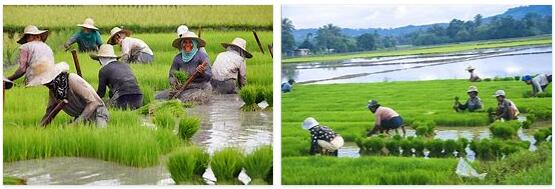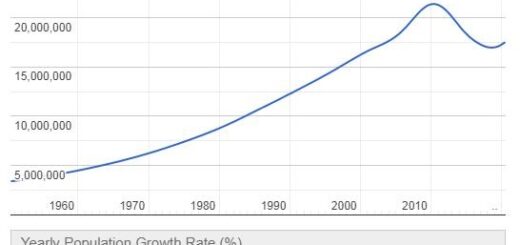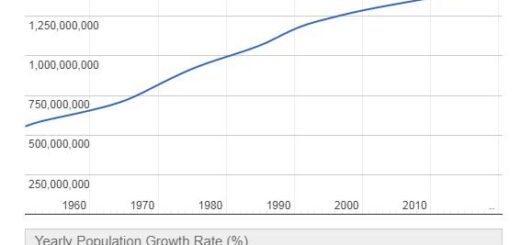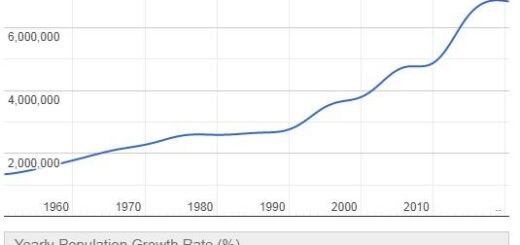Philippines Agriculture
Agriculture. – The Philippine islands have a decidedly agricultural-forestry character: 63.6% of the land is occupied by forests, 18.7% by meadows and uncultivated land, 15.5% by crops.
The archipelago can be divided into four basic economic regions: the area of the farms; the region of the coconut palm; the hemp area and finally the mountainous region: the latter logically the least productive and the least populated. The first region includes the lowlands of Luzon, the great central plain and the Cagayan Valley, and the lowlands of the Panay, Negros and Cebu islands. Rice is the prevalent cereal, which we find widespread in all the islands: the surface, which was 1.1 million hectares in 1913, has risen to 1.8 million in recent years. Today production is around 20-21 million quintals, but it is not enough for local consumption which it makes up for through imports from Siam and French Indochina. The central provinces of
Maize is the second largest cereal in the archipelago: it is grown on all the islands but is particularly important in the islands of Cebu, Negros (eastern section) and Bohol.
Sugar cane, probably imported by the Chinese from Formosa, holds the absolute first place among the crops destined for export. Production has risen from 61,000 quintals in 1855 to over 8 million in recent years. The sugar industry has about thirty factories and is being perfected more and more. The most important provinces for this production are the Occidental Negros, that of Iloilo (Panay), and the provinces of Batangas, Laguna, Pampanga, Tarlac, etc., on the island of Luzon. Another important crop is that of tobacco, already very flourishing under the Spanish domination, since José Basco, governor general of the Philippines, introduced a monopoly regime in 1781. The most valuable qualities come from the northern section of Luzon. Minor crops are those of cotton,
The coconut palm region extends into the southern coastal section of Luzon, and into the coastal strips of the Visayan Islands. In this regard, the Philippines has a world record: the area occupied by the precious plant occupies from 400,000 to 500,000 hectares (246,000 in 1914): the number of plants from 1914 to today has doubled (41.3 million in the period 1910-1913) ; the coconuts harvested were 591,000 in 1914; today, 1.5-2 million. The plant provides a variety of products, including copra and coconut oil, which are heavily exported.
A typical plant of the Philippines is the so-called hemp of Manila or abaca (v.), Which characterizes the third geo-economic region, which includes the eastern section and south-eastern archipelago. The cultivated area fluctuates around 500,000 hectares, with a production of 1.5-2 million quintals of fiber, which is also heavily exported.
Fauna. – The Philippines constitute a faunal zone of the Malay sub-region (eastern region), distinguished by zoogeographic characters, provided not only by other groups, but especially by Mammals. The mammological fauna of the mountains of the island of Luzon has characteristics of primitiveness for which it is clearly connected with the Australian fauna, and is also distinct from the fauna of the island of Celebes. Interesting is, in this mountain fauna of Luzon, the presence of different species of gnawing animals belonging to typically Australian genera (Chrotomys, Xeromys) and of various own species, of the same group, such as the Crateromys schodenbergi, with the appearance of a very considerable mouse. size, the Rhynchomys soricoides, From long and thin snout, different species of the genus Mus such as M. luzonicus, M. neglectus, etc. The fauna of the Luzon plains has a different facies with forms common to the whole eastern region such as Hylobates leuciscus, Viverra tangalunga, Felis bengalensis, and with some species common to Borneo (Paradoxus philippinensis, a carnivore) and Celebes (Sus celebensis) or with its own species such as the Philippine Galeopithecus, the Philippine Tarsier (Tarsius philippinensis), the Philippine Tupaia (Tupaia everetti), the Squirrel and the Philippine Ox, etc. In the Philippines there is a lack of specific species of the Malay fauna such as those of the gen. Arctogale, Herpestes, Cyon, Ursus, Elephas which are widely spread throughout the eastern region.
The avifauna of the Philippines represented by several hundred species, has a considerable number of endemic species and is notable for the absence of species common to the Malay sub-region. The fauna of the lower vertebrates has the characteristic features of the Indo-Malay region. Insects are represented by innumerable species, the Indo-Malay fauna being one of the richest in the world in terms of number of species and variety of forms of Lepidoptera, Coleoptera, Orthoptera, Rincoti, etc. The terrestrial molluscs very interesting for the size reached by the species, for the variety of their forms, are represented in the Philippine islands by about five hundred species.
Livestock farming and fishing. – The breeding is remarkable and varied: pigs prevail (10.6 million heads); there are numerous buffaloes (2 million) and cattle (1.1 million) in the mountainous areas, both of which are used in the strenuous work of the rice fields: goats are also abundant (1.5 million); less numerous sheep (400,000 heads), horses, donkeys and mules (340,000). Fishing is of fundamental importance, both in terms of the value of the product and the number of employees in this economic activity, which is practiced throughout the archipelago from Luzon to Sulu.
Forests. – The forest mantle is widespread in the archipelago: it is estimated that it covers an area of 19.4 million hectares: of these 16.1 million are covered by commercially fruitable forests: in other words 63.6 % of the territory is wooded; 83% of the forests have economic value. The timber industry, which was underdeveloped during the Spanish occupation, gained momentum from 1898 with the creation of numerous sawmills and the Insular Lumber Company. ; it currently employs around 20,000 indigenous workers. The export of timber is mainly directed to the United States (50%), Australia, China, Japan, etc. Also of note are the rubber plantations in the Sulu and Mindanao islands. Bamboo is widespread in all the islands of the archipelago: the most frequent use is for the manufacture of indigenous huts.
Mines. – From the mining point of view, the Philippines are rich, but the development of this industry is still in its infancy. The main gold veins are found in the areas of Masbate, Paracale and Mountain. The most notable iron ore deposits are found in the provinces of Camarines Norte and Bulacan (Luzon) and in the province of Surigao (Mindanao). Surigao’s reserves appear to amount to 500 million tons. The district of Mancayan in the province of Mountain (Luzon) is rich in copper ores; there is no shortage of manganese and tin ore deposits. Coal was first discovered in 1827; the main fields are those of Batan, Cebu, Polillo, Mindanao, Masbate and Mindoro: overall reserves seem to amount to 60 million tons. Oil fields of a certain size are found in the provinces of Tayabas, Leyte, Cebu, Iloilo, on the island of Mindanao, etc. The salt comes entirely from plants that exploit the evaporation of sea water.



